Melitopol
Melitopol (Ukrainian: Меліто́поль, translit. Melitópol’, Russian: Мелитополь) is a city in Zaporizhzhia Oblast (region) of southeastern Ukraine. It is situated on the Molochna[1] River that flows through the eastern edge of the city and into the Molochnyi Lyman, which eventually joins the Sea of Azov. Its population is approximately 151,948 (2020 est.)[2] .
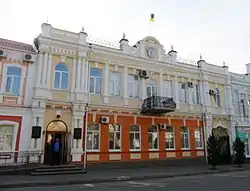
Melitopol
Меліто́поль | |
|---|---|
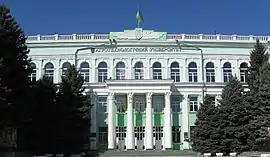 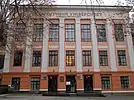 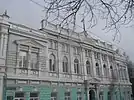 .jpg.webp)  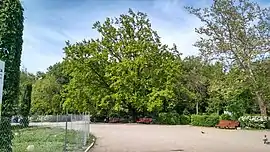 | |
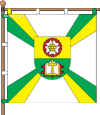 Flag  Seal | |
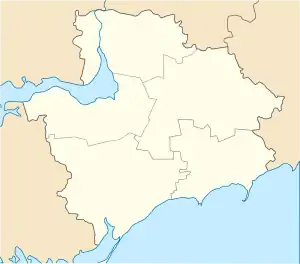 Melitopol Location of Melitopol in Ukraine 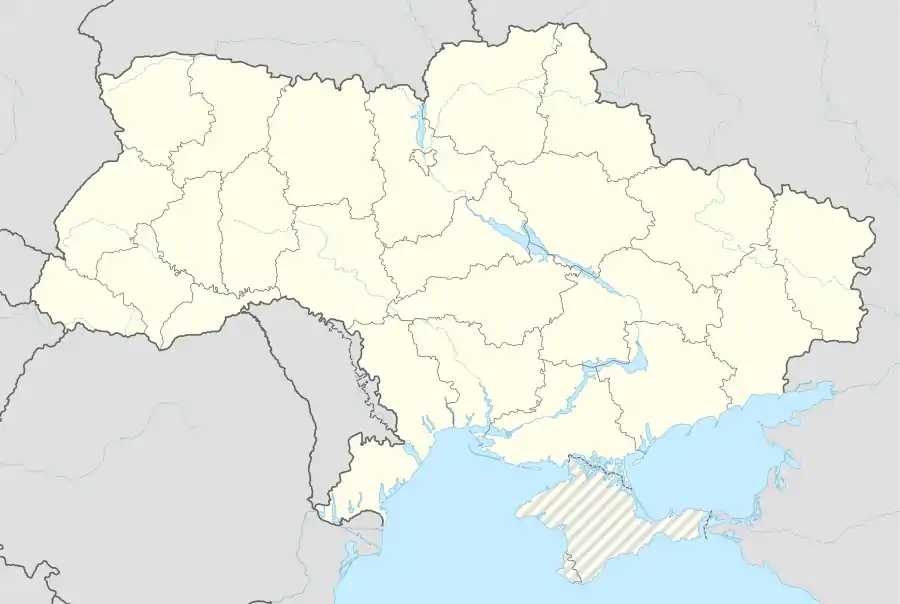 Melitopol Melitopol (Ukraine) | |
| Coordinates: 46°50′N 35°22′E | |
| Country | |
| Oblast | |
| Raions | City of Melitopol |
| Established | 1784 |
| City rights | 1842 |
| Government | |
| • Mayor | Sergiy Minko |
| Area | |
| • Total | 51 km2 (20 sq mi) |
| Population (2020) | |
| • Total | 151,948 |
| Postal Index | 72300 |
| Climate | Cfa |
| Website | www invest-melitopol.org at the Wayback Machine (archived October 30, 2012) |
Melitopol is incorporated as a city of oblast significance and is the second largest city in the oblast after Zaporizhzhia. It serves as the administrative center of Melitopol Raion, though it does not belong to the raion.
The city is located at the crossing of two major European highways E58 Vienna - Uzhhorod - Kyiv - Rostov-on-Don and E105 Kirkenes - St. Petersburg - Moscow - Kyiv - Yalta. An electrified railway line of international importance goes through Melitopol. The city is called "the gateway to the Crimea", prior to the 2014 Russian occupation of Crimea 80% of passenger trains heading to the peninsula passed through the city and during summer road traffic would reach 45,000 vehicles per day.
History
In medieval times, there was a small Noghai aul of Kyzyl-Yar where the modern Melitopol is settled. In July 1769, Russian military commanders built a redoubt there, and Zaporizhia Cossacks carried out their duty service there. On 2 February 1784, Catherine II issued the decree to create the Taurian Province on the lands that had been won. The deputy of Novorossiya Grigory Potemkin signed the relation to establish a town that very year - and Cossacks' families and those of retired soldiers of Suvorov settled on the right bank of the Molochna River. Among others, Germans were encouraged to settle in the new province, and some villages in this area were for many years German-speaking, such as Heidelberg (now Pryshyb) some 50 kilometres (31 miles) to the north of Melitopol.[3]
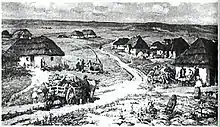
In 1816, the settlement got the name sloboda of Novoalexandrovka. Its population was increasing due to the importation of peasants from the northern provinces of Ukraine and Russia. On J7 January 1842, the sloboda was recognized as a town and received the new name of Melitopol after a port city of Melita (from Greek Μέλι (meli) - "honey") which had been situated on the mouth of the Molochna River. At the end of the 19th century, the "Honey-city"[4] had been developed as a trade center - there were some banks, credit organizations and wholesale stores. The largest enterprises in the city at the time were the iron foundry and the Brothers Klassen's machinery construction factory (1886), the railroad depot and the workshops.
Further development of the city was closely connected with trade, iron and engineering industries, and Crimean direction railway service. In the early twentieth century there were 15 thousand people living in Melitopol. 30 factories and 350 shops operated in the city at that time. In the second half of the twentieth century there was a strong economic growth of the city: new factories, plants, and housing estates were constructed. 16 Melitopol business enterprises have received the All-Soviet Union significance status. Industrial products were exported to more than 50 countries.
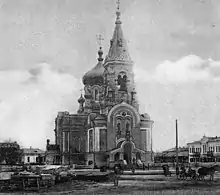
Melitopol in World War II
In 1941, the Soviet Union was attacked by Nazi Germany. The city became strategically important due to its location. The Red Army was not ready for the war and had to retreat. The German Wehrmacht occupied Melitopol on 6 October 1941. Within one week the entire remaining Jewish population of Melitopol (2,000 men, women and children) were murdered by Einsatzgruppe D actively supported by the Wehrmacht.
The Wotan Line Battle
After breaking through on the Mius River and defeating Axis troops in the Donbas and Taganrog, the Soviet Southern Front army pursuing the retreating enemy came to the Molochna River on 22 September 1943. Here, in the basin of the Milk River, German troops had built a strong long-term defence which they called the Panther-Wotan line. It was on this line that the fate of the Crimean peninsula and the whole course of offensive operations in the southern Soviet Union were decided.
The German defense consisted of four lines, covered with solid anti-tank ditches and land mines. The first attempt of the Soviet Southern Front army to break through was unsuccessful. Soviet commanders decided to prepare thoroughly a new attempt: the so-called “Melitopol operation”, which was carried out successfully from 26 September to 5 November 1943.
Despite the courage and heroism of Soviet soldiers, fighting lasted long, as the Germans introduced fresh reserves in order to keep Melitopol. Finally, after many days of heavy street fighting against vastly superior numbers of men and equipment, German resistance was broken and on 23 October the Red Army took complete control of the city. By decrees of the Presidium of the USSR Supreme Soviet, 87 Red soldiers and airmen were awarded the title of "Hero of the Soviet Union" for their actions in the reconquest of Melitopol.
Culture
Melitopol is a melting pot of different ethnicities and cultures. Representatives of more than 100 ethnic groups have been living here together in peace. An association of national-cultural societies is actively working in the city. In 2008 Melitopol became a member of the international project of the Council of Europe "Intercultural Cities". The City confidently and clearly stated its goals in this program. Three flagship projects were identified as belonging to the future of the municipal program "Melitopol - European Intercultural City." The project on which the city works under the Council of Europe project, is called "Creation of Intercultural Park “Melito-Park”. The aim of the project is to create an intercultural park where people of different nationalities could meet and communicate. There is a design project of the Intercultural Park, prepared by a group of European architects and designers led by Mark Glaudemans - Director of the European Laboratory for urban planning, the Dean of the Academy of Architecture and Urbanism (city of Tilburg, Netherlands).[5] In Melitopol removed first short film in 2015, "The Zone". As ethnic conflicts are not a problem for Melitopol, city authorities are trying to identify the potential diversity for the mobilization of efforts and creativity of different ethnic groups to develop and implement innovative projects revival.
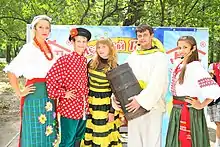
Among all the diversity of cultural events in Melitopol there are these unique activities:
- the Festival of Brides
- "Miss and Mister Interculturality" contest
- the Cherry Festival "Chereshnevo"
- the Honey Festival "Medovo"
Melitopol has 38 monuments, memorials and statues registered.[6]

One of them is the statue of Bohdan Khmelnytsky, the famous hetman of Ukraine. His images are printed on Ukrainian 5 hryvnia's banknotes.
The other one represents Ostap Bender a hero of the book of Ilf and Petrov "12 chairs".
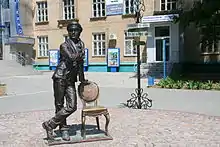
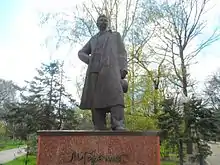
Special notes
.jpg.webp)
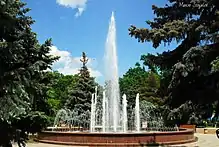
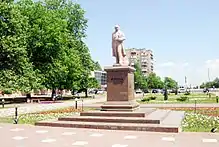
The Stone Grave
There is the unique relic of the Stone Grave (Ukrainian: Кам'яна могила, translit. Kamyana mohyla, Russian: Каменная могила) 12 kilometres (7 miles) north of Melitopol. It is a relic of sandstone from the Sarmatian epoch of the Tertiary period. Its exact coordinates are 46°56′59.33″N 35°28′11.59″E
Melitopol cherries
Melitopol has justly gained fame as "the city of cherries". In the city territory there is, unique in CIS, the Sidorenko Scientific Research Institute of Irrigated Horticulture (Ukrainian Academy of Agrarian Sciences), that is professionally engaged in selection of stone fruit crops (such as cherries, apples, and peaches). The main base of this research institute is located in Melitopol. There are experimental black cherry orchards located in the heart of the city. Citizens of Melitopol rightly call it the "city-garden". A symbol of Melitopol is Chereshnya Melitopolska ("Melitopol cherry"), a type of cherry for which the city is known.
Melitopol honey
Recently, the city actively created its own brand as a "city of honey", which is the translation of the Greek word "melitos". The city formed a cluster of honey producers, prepared investment projects for the establishment of an apitherapy center (treatment with the help of bee products) and encourages the creation of souvenir products made from honey.
Commemorative silver coin
In October 2013, the National Bank of Ukraine introduced a new commemorative silver coin on the 70th anniversary of the Melitopol offensive against German troops and the liberation of the city of Melitopol on 23 October 1943. The new coin was called "The Breakthrough of Soviet Troops Against the German Defence Line Wotan and liberation of Melitopol" and each of the 30,000 limited edition coins worth was the equivalent of $US5.[7]
Twin towns – sister cities
Melitopol is twinned with:
 Brive-la-Gaillarde, France
Brive-la-Gaillarde, France Barysaw, Belarus
Barysaw, Belarus Pukhavichy Raion, Belarus
Pukhavichy Raion, Belarus Kedainiai, Lithuania
Kedainiai, Lithuania Sliven, Bulgaria
Sliven, Bulgaria
Education
In 1874, a technical school was founded in the city, which, after a series of reforms and transformations, became Tavria State Agrotechnological University.
The city now has two public universities − Tavria State Agrotechnological Academy[8] and Bohdan Khmelnytsky Melitopol State Pedagogical University,[9] as well as a private institute - Zaporizhzhia Institute of Economics and Information Technologies.
A long history of universities and schools is one of the reasons that Melitopol is called "the city of students". More than 10% of its citizens are students.
The strong system of education is represented by different types of educational institutions at all levels of accreditation: two universities, four branches of different universities in Ukraine, seven professional schools, and three colleges.
26 pre-schools are operating in the city, in which 6,000 young citizens are being educated. In addition, for more than 500 children with special needs under the age of seven years there are rehabilitation programs to provide the needed services.
Educational services for 14,000 students are provided by 23 secondary schools. There is a center of labor training and professional orientation for young people. A network of six non-school institutions are the following: the Centre of Ecological-Naturalistic Art for Youth, the Center of Tourist and Local Lore Creativity for Youth, the Station of Young Technicians, the Vodvudenko Palace for Children and Teenagers Creativity, Small Academy of Sciences, and the Center of Children and Teenagers. Other creative centers unite nine communal hobby clubs.
Transportation
- Melitopol Railway Station serves as the transit point for passengers going from Moscow to the Crimea and back. The city is also called the "gateway to the Crimea".
- The city's cantonment has an aerodrome, which is not used for passenger service. There is based a 25th Transport Aviation Brigade.
- The city has two bus stations: the newer intercity station, and the old station of local buses. Two highways lead through Melitopol: The M14 Odesa-Novoazovsk Highway and the M26 Kharkiv-Simferopol National Highway.
- The marshrutkas are the sole kind of the city's public transport. They run 34 routes. They work from 5:00 a.m. to 12:30 a.m. (from 05:30 to 00:30). Formerly, during the time of the USSR, there were buses of Ikarus, LiAZ, LAZ, PAZ running around 15 routes.
- The common length of the roads of Melitopol is 333 km (207 mi); 70% of them do not meet the basic requirements.
Industry
There is a well-developed, internationally important engine-constructing industry. Thanks to the rich historical heritage, economic and geographical situation and enterprising citizens the city has developed mechanical engineering, light and food industry. The city's development is driven by engineering industries, that have received new impulse with the establishment of more than 100 new small and medium engineering business enterprises, united in the cluster "AgroBOOM".
Machine engineering complex of the city is represented by 8 large plants and more than 100 small and medium-sized enterprises formed after 1991. Mechanical engineers of the city mainly produce goods for the agricultural sector.
Enterprises include:
- The plant BIOL makes dishes,
- The plant TALCO collaborates with General Motors and Festo.
- The plant AUTOPRIVOD is produces YaMZ engines.
- The only plant in the Ukraine that produces engines for cars is AvtoZAZ-MOTOR.
- The plant AVTOTSVETLIT is the only plant in Ukraine that produces five types of complex castings (steel, cast iron, magnesium, and aluminium); it also produces shock absorbers for VAZ.
- The company ROSTA performs the commercialisation of research in agricultural machinery and irrigation systems.
- The plant MzTK is a unique enterprise that produces turbines for mobile equipment.
- The plant TERMOLIT induction furnaces for foundry operations and other products of metal processing.
The following companies can be called the basis of light industry in the city:
- Melitopol Sewing Production Enterprise exports its goods. The factory has "dressed" the Air France and Polaris French railway employees, Dutch police and firefighters, and Italian tax police.
- Melitopol Knitting Factory Nadezhda is a manufacturer of knitwear products.
- Furniture production is well developed; more than 20 small and medium enterprises are working in this field, distributing its products throughout Ukraine.
Thanks to the proximity of agricultural areas and raw materials of Zaporizhzhia, Mykolaiv, Kherson, and Dnipropetrovsk regions, the food industry is well presented in the city. The main enterprises of the food industry are:
- Melitopol Meat Processing Plant produces sausages.
- Melitopol Milk Plant and Oil Extraction Plant are enterprises that belong to a major food-holding, Olkom.
- Melitopol grain elevator.
People from Melitopol
- Grigory Chukhray, Soviet film director and screenwriter
- Dmytro Dontsov, influenced the establishment of OUN
- Mikhail Lifshitz, Soviet philosopher of art
- Pavlo Sudoplatov, lieutenant-general of KGB; killed Yevhen Konovalets
- Yevhen Khacheridi, footballer
References
Notes
- Milky
- "Чисельність наявного населення України (Actual population of Ukraine)" (PDF) (in Ukrainian). State Statistics Service of Ukraine. Retrieved 30 September 2020.
- Richard Konkel, genealogist
- i.e. Melitopol, this is how Melitopol sometimes is referred in the local mass-media
- information from the Melitopol investment portal http://invest-melitopol.org Archived 2012-10-30 at the Wayback Machine
- The data from Melitopol's official site - mlt.gov.ua (uk.)
- "National Bank of Ukraine issues commemorative coin". Cistran Finance. 21 October 2013. Archived from the original on 29 October 2013. Retrieved 25 October 2013.
- Tavria State Agrotechnological Academy official site
- Melitopol State Pedagogical University official site
External links
| Wikimedia Commons has media related to Melitopol. |
_2.JPG.webp)